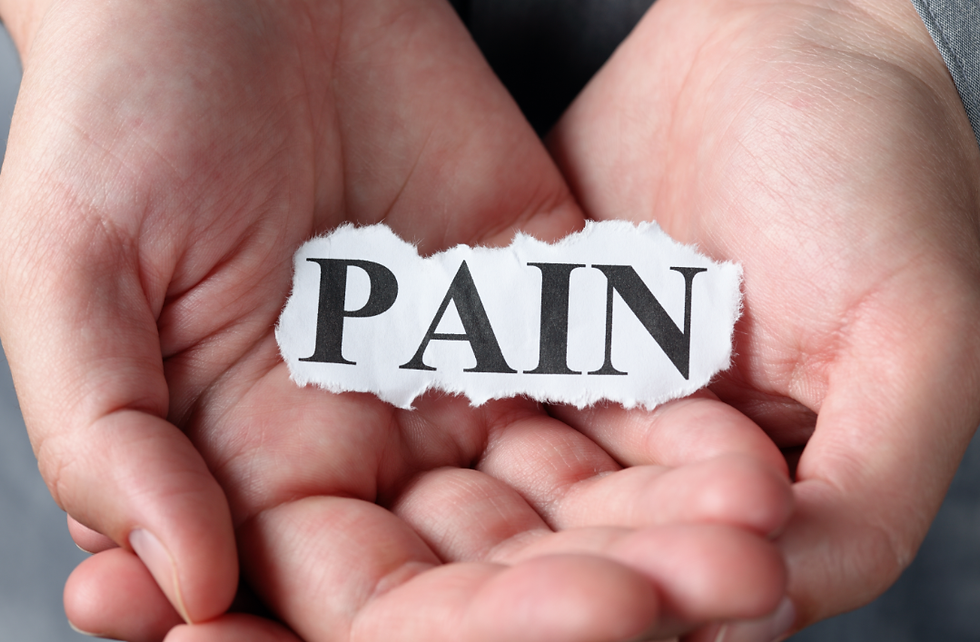How Does an Individual Perceive Pain?
- Dr. Richa Bhaskarwar
- Aug 26
- 3 min read
Pain is something we have all experienced, yet very few people truly understand it. Most believe it works like a simple alarm: you get hurt, so you feel pain.
But pain is not just a raw signal from your body. It is a decision your brain makes after weighing your body’s condition, your emotions, your past experiences, and even what is happening around you at that exact moment.

Pain is Processed, Not Just Felt!
Lifting a heavy suitcase
Two people lift the same heavy bag incorrectly. One feels a mild ache and keeps going. The other can barely straighten up. The second person might be stressed, sleep-deprived, or have a history of back injury or muscle weakness.
Their brain interprets the same situation as more dangerous and increases the pain.
Stubbing your toe
The same stub can feel different depending on your mood. If it happens during an argument, it feels sharper.
If it happens while you are laughing with friends, it is easier to brush off.
Athletes in competition
Many athletes finish a race or match with an injury they do not notice until later. While they are focused on the game, the brain decides it is not the right time for pain to be felt. Once the event is over, the pain signal comes through.
Children and social cues
A child may fall and stay calm until they see a worried parent.
That moment of social feedback tells the brain this could be serious, and the pain increases.
Your Brain Follows a Safety Checklist

Before deciding how much pain you will feel, your brain runs through a quick set of questions:
Have we felt this before?
Does it seem dangerous?
Are we stressed or calm?
Are we alone or supported?
What does this pain mean to us?
It works like a security guard deciding whether to quietly watch the situation or set off the full alarm.
Now, let’s learn how it sounds medically.
The Pain Gate Mechanism
Inside your spinal cord, there is a “gate” that controls how much pain information passes to the brain. This is called the pain gate mechanism.
When you bump your elbow and instinctively rub it, you send touch signals through the same nerve pathways. These signals can close the gate slightly, reducing the pain. The same thing happens when you apply ice or heat.
Emotions and focus also influence the gate. Feeling calm and safe can help close it, while stress, fear, and uncertainty can open it wider.
This is why the same injury can feel mild in one situation and much worse in another.
Pain Is Real, Even When It Is In The Brain
All pain is processed in the brain, but that does not make it imaginary.
It makes it complex. Sometimes an injury has healed, but the brain keeps the alarm running. This can happen with chronic back pain, fibromyalgia, or lingering discomfort after surgery. The brain has learned to stay on alert even when there is no ongoing damage.
Pain as a Smoke Alarm
Pain can be compared to a smoke alarm. Sometimes there is a real fire, such as a fresh injury. Other times, it is only steam from the shower—stress, fear, or old trauma. The alarm still goes off either way.
This is why managing pain is not only about treating the body. It also means calming the nervous system, restoring safe movement, building confidence, and helping the brain feel secure again.
A Question Worth Asking!
The next time pain lingers longer than you expect, pause for a moment.
Instead of only asking, “What is wrong with my body?” try also asking, “What might my brain be protecting me from?”
It could be protecting you from moving in a way it remembers as dangerous, even if you are no longer injured. It could be slowing you down because you have been under constant stress, and your body needs rest. It could be keeping you away from situations that your nervous system still links to a past trauma.
For example:
A runner who once hurt their knee might feel pain flare up the moment they start training again, even though the knee is physically healed.
Someone recovering from back surgery might feel twinges when bending, not because of new damage, but because their brain is on high alert.
A person under intense work stress might develop headaches or muscle aches as the brain’s way of saying, “You need to slow down.”
Sometimes the brain rings the pain alarm to protect us.
The key is learning whether there is a real fire or just steam from the shower. Understanding that difference can be the first real step toward healing.




Comments